Jeff Daniels looks at what could possibly be Europe’s largest construction project gearing up at the moment beneath the streets of London.
Draw a horizontal line smack through the centre of London from Heathrow Airport in the west to the financial district of Canary Wharf in the east, and you have a rough idea of where Britain’s biggest civil construction project is to be found.
It is the newest rail line in the country and the biggest single extension to the south-east network in half a century. But the route will be far from a straight line: instead, it will weave its way between existing underground lines, sewers, utility tunnels and building foundations from station to station at depths of up to 36 metres.
With more than a passing resemblance to the Channel Tunnel Rail Link, Crossrail—as the project is known—will deliver a high-frequency, high-capacity service to 37 stations linking Maidenhead on the Berkshire side of the M25 to Shenfield on the Essex side, via 21 kilometres of new twin-bore tunnels under central London. Head east, and shortly after Liverpool Street Station, the line divides to serve both sides of the River Thames.
For an estimated cost of £17 billion, it will add 10 per cent to the capital’s rail capacity and bring an additional 1.5 million people within 45 minutes commuting distance of London's key business districts. By carrying an anticipated 200 million passengers per year, it will bring much needed relief to other parts of the rail and road network.
But as with everything in the UK, it has been a slow process—not because of engineering inadequacies but rather the bureaucratic need to give everyone the chance to voice an objection. As such, the process began in 2005 when a bill to build the railway was introduced to parliament.
After three years of consultation and scrutiny in both houses of parliament, the Crossrail Bill was enacted in July 2008, with Royal Assent turning an idea into the beginning of reality. The construction project is being managed by Crossrail Ltd—now a fully owned subsidiary of TfL, the body that runs London’s underground network.
Despite spending much of its time below the surface, the line will be more akin to normal commuter trains than the Underground. The plan is to run a fleet of fixed-formation, 10-car, mainline-size trains measuring 200 metres in length and capable of each carrying more than 1,500 passengers during peak periods. The plan is that by ordering 63 such trains, it will enable 57 sets to be in service during peak hours. The project promises high-speed travel and is being designed for speeds of up to 160 kilometres per hour on the surface parts of the route and up to 100 kilometres per hour in the tunnels.
Considerable work has been conducted with Network Rail and the various freight and passenger franchisee holders that are linked with Crossrail. The planning team has carried out extensive simulations of future services operating on the rail network, indicating that a high level of punctuality of services can be achieved with at least 24 trains per hour at peak times in each direction. Worst case scenarios have also been simulated—including signal failures, extended dwell times and interfering freight paths—to see what impact would occur and how best to improve traffic flow. As a result, Crossrail has developed a programme to continue testing the timetable model, enabling fine-tuning of all variables impacting on punctuality.
Above ground, the new line will need to be integrated into the network currently being used by the Great Eastern, Great Western and North Kent mainlines. But it is the section under central London that will create the most challenges and engineering interest.
New Crossrail stations, costing in the region of £2 billion, will be constructed along the central route at Paddington, Tottenham Court Road, Bond Street, Farringdon, Liverpool Street, Whitechapel and Canary Wharf. As many as 65 new escalators will be needed here alone, with another 40 or more outside the central district. Combined, this could be the UK’s largest single contract for the supply and maintenance of escalators. Work sites have been established for each of these stations throughout central London, with main construction of the stations due to commence late this year.
Just as with the Channel Tunnel, work will commence from both ends, working towards the centre. In spring 2012, the first tunnel boring machines (TBMs) will start on their journey from Royal Oak towards the west of Farringdon station. This will be followed shortly by the launch of further TBMs in Docklands that will head under central London towards the east of Farringdon.
Crossrail will use eight TBMs working 24 hours a day beneath the streets of London, excavating large volumes of ground and erecting the concrete tunnel lining. TBMs are best suited to longer tunnel drives where the cross-sectional profile remains constant and where finished precast concrete linings can be erected directly behind the machine. They also limit the disturbance to the surrounding ground and the surface above, making them ideal for use in heavily urbanized areas.
Tunnelling is such a crucial aspect of the project that the Tunnelling and Underground Construction Academy (TUCA) has been established. In its final stages of completion, TUCA will provide purpose-built training facilities in the provision of key skills required to work in tunnel excavation, underground construction and infrastructure. Equally important, it will ensure that everyone working underground has the necessary safety training in the form of the obligatory Tunnel Safety Card.
The main civil engineering construction works for Crossrail are planned to complete in 2017; but it will then need to fit out the stations and conduct exhaustive tests, so it will be late 2018 before the central section is put into service, followed by a phased introduction of services along the rest of the Crossrail route over several months.
By this time, the industry is hoping that the next big rail infrastructure project for the UK—the proposed London to Birmingham (and beyond) HS2 (High Speed 2) rail line—will have cleared all its own hurdles, offering more opportunities for the companies that have brought Crossrail to the capital. www.crossrail.co.uk
DOWNLOAD
 Crossrail_JUL11_emea_BROCH_s.pdf
Crossrail_JUL11_emea_BROCH_s.pdf













